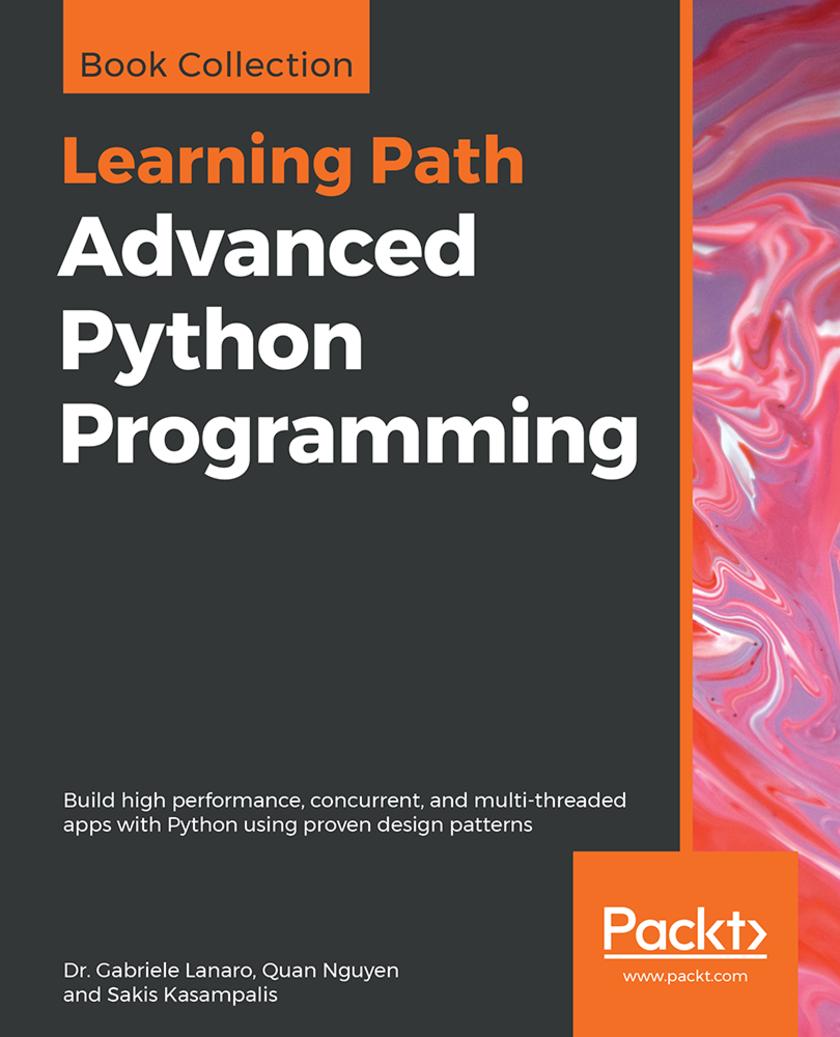
Advanced Python Programming
¥90.46
Create distributed applications with clever design patterns to solve complex problems Key Features * Set up and run distributed algorithms on a cluster using Dask and PySpark * Master skills to accurately implement concurrency in your code * Gain practical experience of Python design patterns with real-world examples Book Description This Learning Path shows you how to leverage the power of both native and third-party Python libraries for building robust and responsive applications. You will learn about profilers and reactive programming, concurrency and parallelism, as well as tools for making your apps quick and efficient. You will discover how to write code for parallel architectures using TensorFlow and Theano, and use a cluster of computers for large-scale computations using technologies such as Dask and PySpark. With the knowledge of how Python design patterns work, you will be able to clone objects, secure interfaces, dynamically choose algorithms, and accomplish much more in high performance computing. By the end of this Learning Path, you will have the skills and confidence to build engaging models that quickly offer efficient solutions to your problems. This Learning Path includes content from the following Packt products: * Python High Performance - Second Edition by Gabriele Lanaro * Mastering Concurrency in Python by Quan Nguyen * Mastering Python Design Patterns by Sakis Kasampalis What you will learn * Use NumPy and pandas to import and manipulate datasets * Achieve native performance with Cython and Numba * Write asynchronous code using asyncio and RxPy * Design highly scalable programs with application scaffolding * Explore abstract methods to maintain data consistency * Clone objects using the prototype pattern * Use the adapter pattern to make incompatible interfaces compatible * Employ the strategy pattern to dynamically choose an algorithm Who this book is for This Learning Path is specially designed for Python developers who want to build high-performance applications and learn about single core and multi-core programming, distributed concurrency, and Python design patterns. Some experience with Python programming language will help you get the most out of this Learning Path.
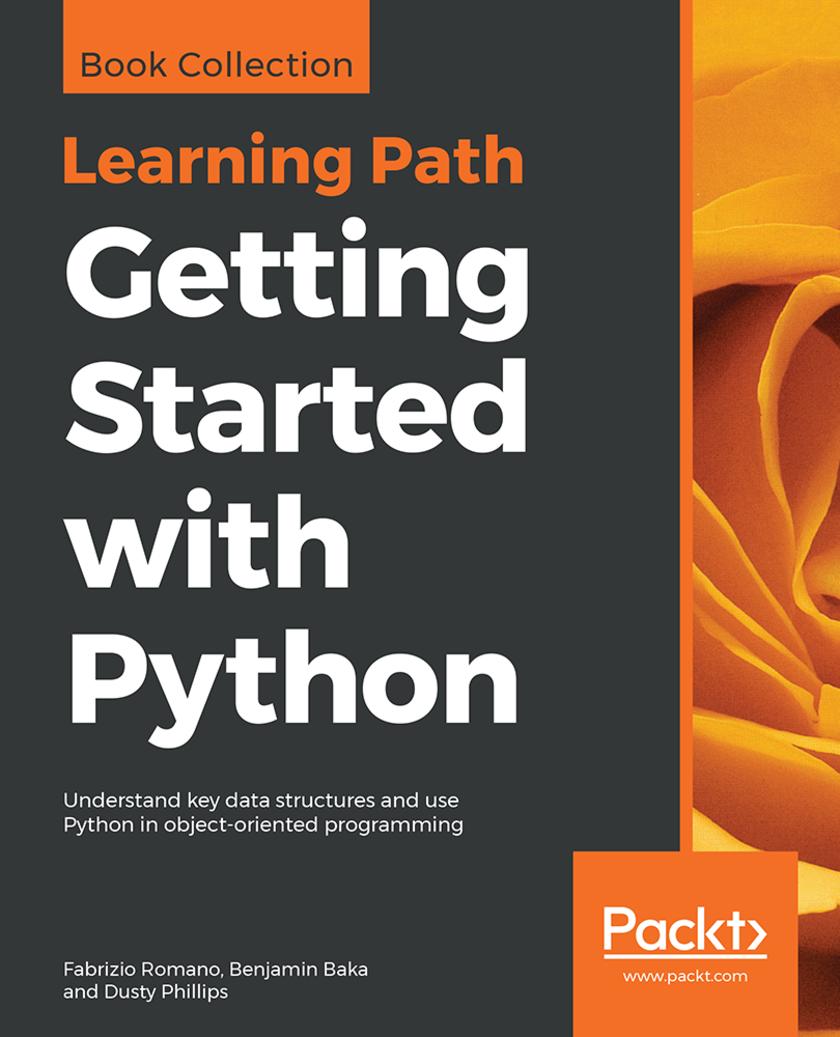
Getting Started with Python
¥90.46
Harness the power of Python objects and data structures to implement algorithms for analyzing your data and efficiently extracting information Key Features * Turn your designs into working software by learning the Python syntax * Write robust code with a solid understanding of Python data structures * Understand when to use the functional or the OOP approach Book Description This Learning Path helps you get comfortable with the world of Python. It starts with a thorough and practical introduction to Python. You’ll quickly start writing programs, building websites, and working with data by harnessing Python's renowned data science libraries. With the power of linked lists, binary searches, and sorting algorithms, you'll easily create complex data structures, such as graphs, stacks, and queues. After understanding cooperative inheritance, you'll expertly raise, handle, and manipulate exceptions. You will effortlessly integrate the object-oriented and not-so-object-oriented aspects of Python, and create maintainable applications using higher level design patterns. Once you’ve covered core topics, you’ll understand the joy of unit testing and just how easy it is to create unit tests. By the end of this Learning Path, you will have built components that are easy to understand, debug, and can be used across different applications. This Learning Path includes content from the following Packt products: * Learn Python Programming - Second Edition by Fabrizio Romano * Python Data Structures and Algorithms by Benjamin Baka * Python 3 Object-Oriented Programming by Dusty Phillips What you will learn * Use data structures and control flow to write code * Use functions to bundle together a sequence of instructions * Implement objects in Python by creating classes and defining methods * Design public interfaces using abstraction, encapsulation and information hiding * Raise, define, and manipulate exceptions using special error objects * Create bulletproof and reliable software by writing unit tests * Learn the common programming patterns and algorithms used in Python Who this book is for If you are relatively new to coding and want to write scripts or programs to accomplish tasks using Python, or if you are an object-oriented programmer for other languages and seeking a leg up in the world of Python, then this Learning Path is for you. Though not essential, it will help you to have basic knowledge of programming and OOP.
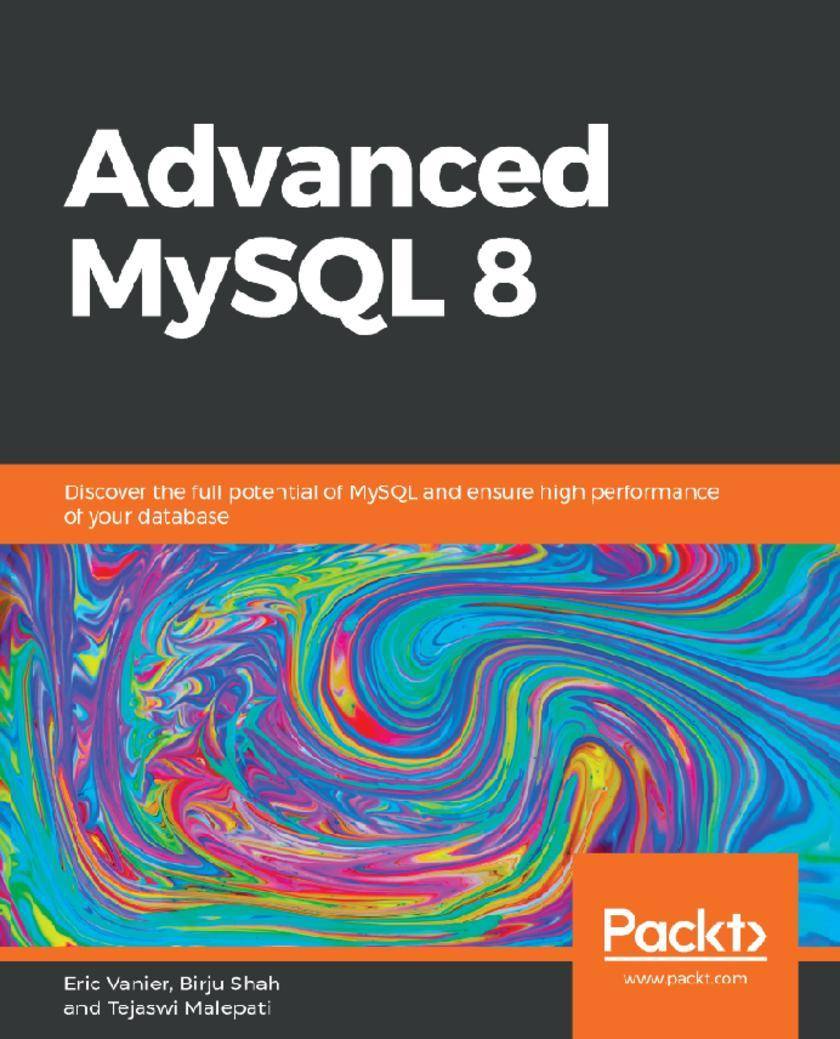
Advanced MySQL 8
¥73.02
Design cost-efficient database solutions, scale enterprise operations and reduce overhead business costs with MySQL Key Features * Explore the new and advanced features of MySQL 8.0 * Use advanced techniques to optimize MySQL performance * Create MySQL-based applications for your enterprise with the help of practical examples Book Description Advanced MySQL 8 teaches you to enhance your existing database infrastructure and build various tools to improve your enterprise applications and overall website performance. The book starts with the new and exciting MySQL 8.0 features and how to utilize them for maximum efficiency. As you make your way through the chapters, you will learn to optimize MySQL performance using indexes and advanced data query techniques for large queries. You will also discover MySQL Server 8.0 settings and work with the MySQL data dictionary to boost the performance of your database. In the concluding chapters, you will cover MySQL 8.0 Group Replication, which will enable you to create elastic, highly available, and fault-tolerant replication topologies. You will also explore backup and recovery techniques for your databases and understand important tips and tricks to help your critical data reach its full potential. By the end of this book, you’ll have learned about new MySQL 8.0 security features that allow a database administrator (DBA) to simplify user management and increase the security of their multi-user environments. What you will learn * Explore new and exciting features of MySQL 8.0 * Analyze and optimize large MySQL queries * Understand MySQL Server 8.0 settings * Master the deployment of Group Replication and use it in an InnoDB cluster * Monitor large distributed databases * Discover different types of backups and recovery methods for your databases * Explore tips to help your critical data reach its full potential Who this book is for Advanced MySQL 8 is for database administrators, data architects, and database developers who want to dive deeper into building advanced database applications in the MySQL environment.
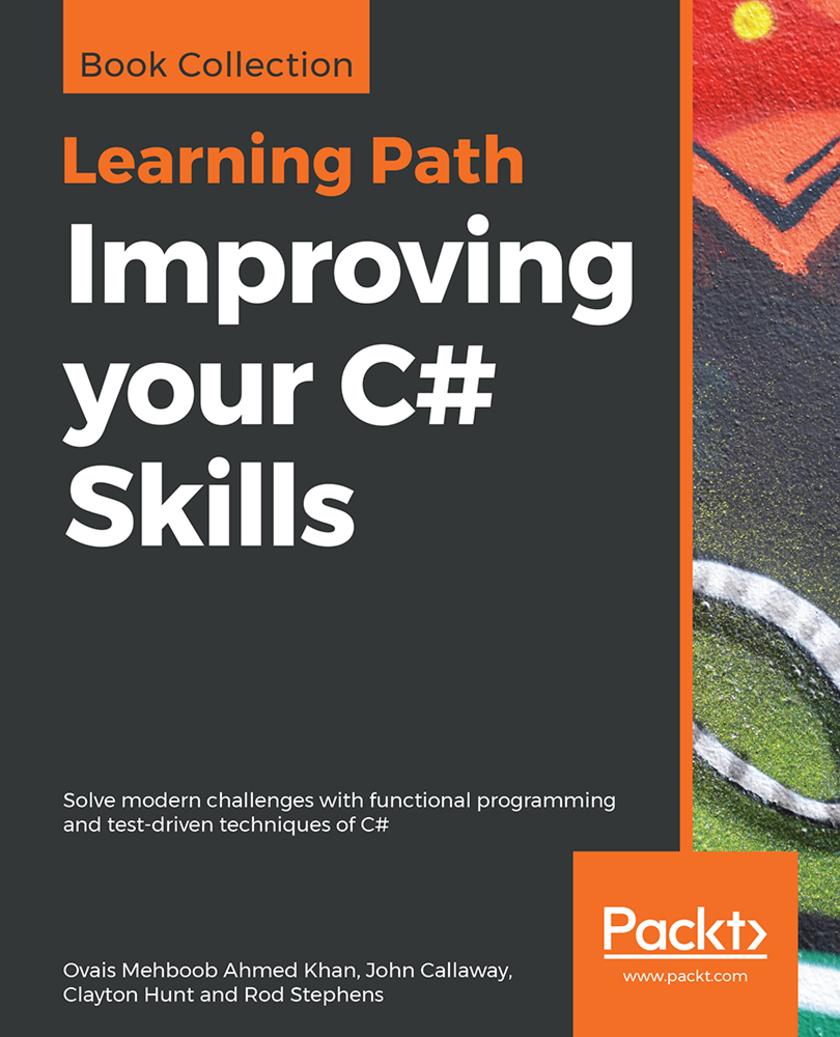
Improving your C# Skills
¥90.46
Conquer complex and interesting programming challenges by building robust and concurrent applications with caches, cryptography, and parallel programming. Key Features * Understand how to use .NET frameworks like the Task Parallel Library (TPL)and CryptoAPI * Develop a containerized application based on microservices architecture * Gain insights into memory management techniques in .NET Core Book Description This Learning Path shows you how to create high performing applications and solve programming challenges using a wide range of C# features. You’ll begin by learning how to identify the bottlenecks in writing programs, highlight common performance pitfalls, and apply strategies to detect and resolve these issues early. You'll also study the importance of micro-services architecture for building fast applications and implementing resiliency and security in .NET Core. Then, you'll study the importance of defining and testing boundaries, abstracting away third-party code, and working with different types of test double, such as spies, mocks, and fakes. In addition to describing programming trade-offs, this Learning Path will also help you build a useful toolkit of techniques, including value caching, statistical analysis, and geometric algorithms. This Learning Path includes content from the following Packt products: * C# 7 and .NET Core 2.0 High Performance by Ovais Mehboob Ahmed Khan * Practical Test-Driven Development using C# 7 by John Callaway, Clayton Hunt * The Modern C# Challenge by Rod Stephens What you will learn * Measure application performance using BenchmarkDotNet * Leverage the Task Parallel Library (TPL) and Parallel Language Integrated Query (PLINQ)library to perform asynchronous operations * Modify a legacy application to make it testable * Use LINQ and PLINQ to search directories for files matching patterns * Find areas of polygons using geometric operations * Randomize arrays and lists with extension methods * Use cryptographic techniques to encrypt and decrypt strings and files Who this book is for If you want to improve the speed of your code and optimize the performance of your applications, or are simply looking for a practical resource on test driven development, this is the ideal Learning Path for you. Some familiarity with C# and .NET will be beneficial.

Mastering Tableau 2019.1
¥81.74
Build, design and improve advanced business intelligence solutions using Tableau’s latest features, including Tableau Prep, Tableau Hyper, and Tableau Server Key Features * Master new features in Tableau 2019.1 to solve real-world analytics challenges * Perform Geo-Spatial Analytics, Time Series Analysis, and self-service analytics using real-life examples * Build and publish dashboards and explore storytelling using Python and MATLAB integration support Book Description Tableau is one of the leading business intelligence (BI) tools used to solve BI and analytics challenges. With this book, you will master Tableau's features and offerings in various paradigms of the BI domain. This book is also the second edition of the popular Mastering Tableau series, with new features, examples, and updated code. The book covers essential Tableau concepts and its advanced functionalities. Using Tableau Hyper and Tableau Prep, you’ll be able to handle and prepare data easily. You’ll gear up to perform complex joins, spatial joins, union, and data blending tasks using practical examples. Following this, you’ll learn how to perform data densification to make displaying granular data easier. Next, you’ll explore expert-level examples to help you with advanced calculations, mapping, and visual design using various Tableau extensions. With the help of examples, you’ll also learn about improving dashboard performance, connecting Tableau Server, and understanding data visualizations. In the final chapters, you’ll cover advanced use cases such as Self-Service Analytics, Time Series Analytics, and Geo-Spatial Analytics, and learn to connect Tableau to R, Python, and MATLAB. By the end of this book, you’ll have mastered the advanced offerings of Tableau and be able to tackle common and not-so-common challenges faced in the BI domain. What you will learn * Get up to speed with various Tableau components * Master data preparation techniques using Tableau Prep * Discover how to use Tableau to create a PowerPoint-like presentation * Understand different Tableau visualization techniques and dashboard designs * Interact with the Tableau server to understand its architecture and functionalities * Study advanced visualizations and dashboard creation techniques * Brush up on powerful Self-Service Analytics, Time Series Analytics, and Geo-Spatial Analytics Who this book is for This book is designed for business analysts, BI professionals and data analysts who want to master Tableau to solve a range of data science and business intelligence problems. The book is ideal if you have a good understanding of Tableau and want to take your skills to the next level.

Serverless Integration Design Patterns with Azure
¥81.74
A practical guide that helps you progress to using modern integration methods and leverage new cloud capability models Key Features * Design critical hybrid integration solutions for your organization * Gain in-depth knowledge of how to build cloud-native integration solutions * Leverage cognitive services to build smart cloud solutions Book Description With more enterprises adapting cloud-based and API-based solutions, application integration has become more relevant and significant than ever before. Parallelly, Serverless Integration has gained popularity, as it helps agile organizations to build integration solutions quickly without having to worry about infrastructure costs. With Microsoft Azure’s serverless offerings, such as Logic Apps, Azure Functions, API Management, Azure Event Grid and Service Bus, organizations can build powerful, secure, and scalable integration solutions with ease. The primary objective of this book is to help you to understand various serverless offerings included within Azure Integration Services, taking you through the basics and industry practices and patterns. This book starts by explaining the concepts of services such as Azure Functions, Logic Apps, and Service Bus with hands-on examples and use cases. After getting to grips with the basics, you will be introduced to API Management and building B2B solutions using Logic Apps Enterprise Integration Pack. This book will help readers to understand building hybrid integration solutions and touches upon Microsoft Cognitive Services and leveraging them in modern integration solutions. Industry practices and patterns are brought to light at appropriate opportunities while explaining various concepts. What you will learn * Learn about the design principles of Microsoft Azure Serverless Integration * Get insights into Azure Functions, Logic Apps, Azure Event Grid and Service Bus * Secure and manage your integration endpoints using Azure API Management * Build advanced B2B solutions using Logic Apps, Enterprise Integration Pack * Monitor integration solutions using tools available on the market * Discover design patterns for hybrid integration Who this book is for Serverless Integration Design Patterns with Azure is for you if you are a solution architect or integration professional aiming to build complex cloud solutions for your organization. Developers looking to build next-level hybrid or cloud solutions will also find this book useful. Prior programming knowledge is necessary.
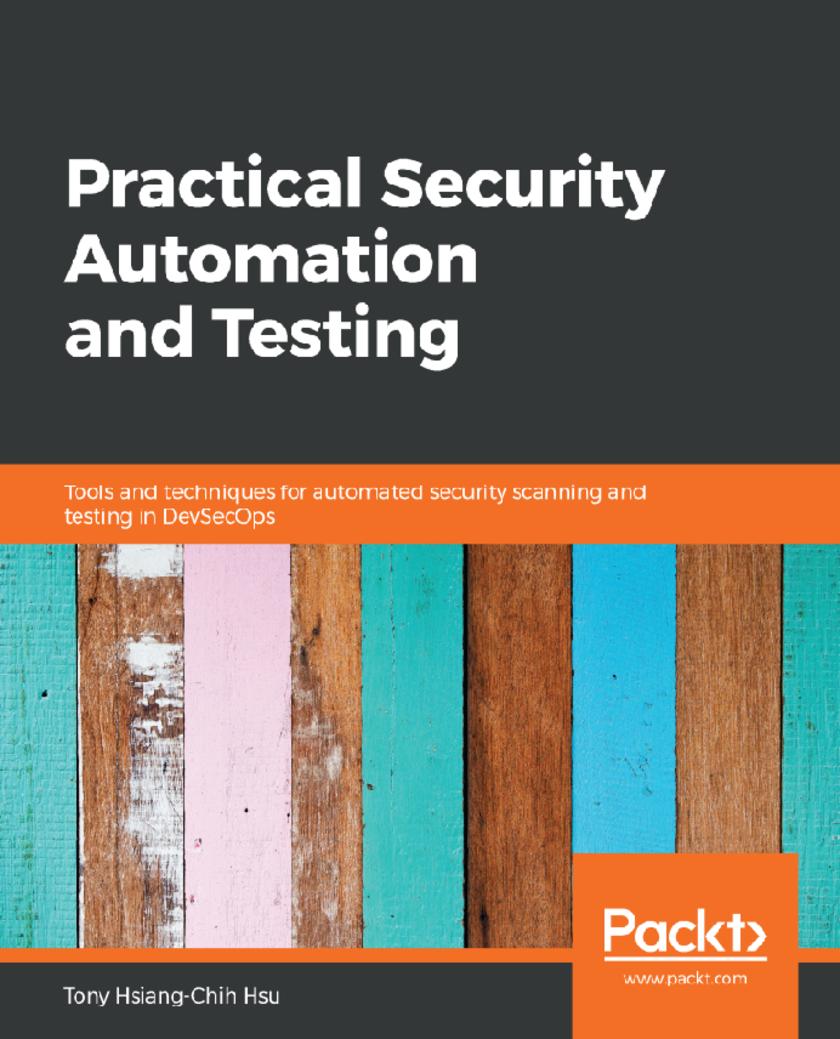
Practical Security Automation and Testing
¥73.02
Your one stop guide to automating infrastructure security using DevOps and DevSecOps Key Features * Secure and automate techniques to protect web, mobile or cloud services * Automate secure code inspection in C++, Java, Python, and JavaScript * Integrate security testing with automation frameworks like fuzz, BDD, Selenium and Robot Framework Book Description Security automation is the automatic handling of software security assessments tasks. This book helps you to build your security automation framework to scan for vulnerabilities without human intervention. This book will teach you to adopt security automation techniques to continuously improve your entire software development and security testing. You will learn to use open source tools and techniques to integrate security testing tools directly into your CI/CD framework. With this book, you will see how to implement security inspection at every layer, such as secure code inspection, fuzz testing, Rest API, privacy, infrastructure security, and web UI testing. With the help of practical examples, this book will teach you to implement the combination of automation and Security in DevOps. You will learn about the integration of security testing results for an overall security status for projects. By the end of this book, you will be confident implementing automation security in all layers of your software development stages and will be able to build your own in-house security automation platform throughout your mobile and cloud releases. What you will learn * Automate secure code inspection with open source tools and effective secure code scanning suggestions * Apply security testing tools and automation frameworks to identify security vulnerabilities in web, mobile and cloud services * Integrate security testing tools such as OWASP ZAP, NMAP, SSLyze, SQLMap, and OpenSCAP * Implement automation testing techniques with Selenium, JMeter, Robot Framework, Gauntlt, BDD, DDT, and Python unittest * Execute security testing of a Rest API Implement web application security with open source tools and script templates for CI/CD integration * Integrate various types of security testing tool results from a single project into one dashboard Who this book is for The book is for software developers, architects, testers and QA engineers who are looking to leverage automated security testing techniques.
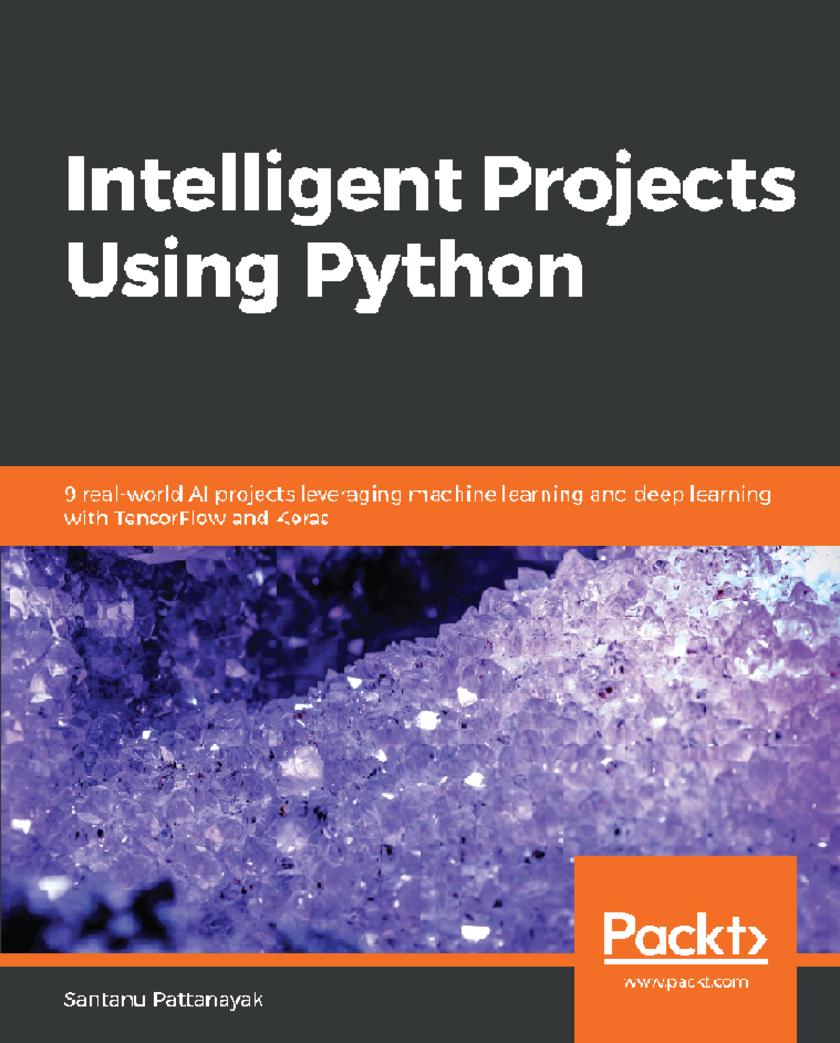
Intelligent Projects Using Python
¥73.02
Implement machine learning and deep learning methodologies to build smart, cognitive AI projects using Python Key Features * A go-to guide to help you master AI algorithms and concepts * 8 real-world projects tackling different challenges in healthcare, e-commerce, and surveillance * Use TensorFlow, Keras, and other Python libraries to implement smart AI applications Book Description This book will be a perfect companion if you want to build insightful projects from leading AI domains using Python. The book covers detailed implementation of projects from all the core disciplines of AI. We start by covering the basics of how to create smart systems using machine learning and deep learning techniques. You will assimilate various neural network architectures such as CNN, RNN, LSTM, to solve critical new world challenges. You will learn to train a model to detect diabetic retinopathy conditions in the human eye and create an intelligent system for performing a video-to-text translation. You will use the transfer learning technique in the healthcare domain and implement style transfer using GANs. Later you will learn to build AI-based recommendation systems, a mobile app for sentiment analysis and a powerful chatbot for carrying customer services. You will implement AI techniques in the cybersecurity domain to generate Captchas. Later you will train and build autonomous vehicles to self-drive using reinforcement learning. You will be using libraries from the Python ecosystem such as TensorFlow, Keras and more to bring the core aspects of machine learning, deep learning, and AI. By the end of this book, you will be skilled to build your own smart models for tackling any kind of AI problems without any hassle. What you will learn * Build an intelligent machine translation system using seq-2-seq neural translation machines * Create AI applications using GAN and deploy smart mobile apps using TensorFlow * Translate videos into text using CNN and RNN * Implement smart AI Chatbots, and integrate and extend them in several domains * Create smart reinforcement, learning-based applications using Q-Learning * Break and generate CAPTCHA using Deep Learning and Adversarial Learning Who this book is for This book is intended for data scientists, machine learning professionals, and deep learning practitioners who are ready to extend their knowledge and potential in AI. If you want to build real-life smart systems to play a crucial role in every complex domain, then this book is what you need. Knowledge of Python programming and a familiarity with basic machine learning and deep learning concepts are expected to help you get the most out of the book
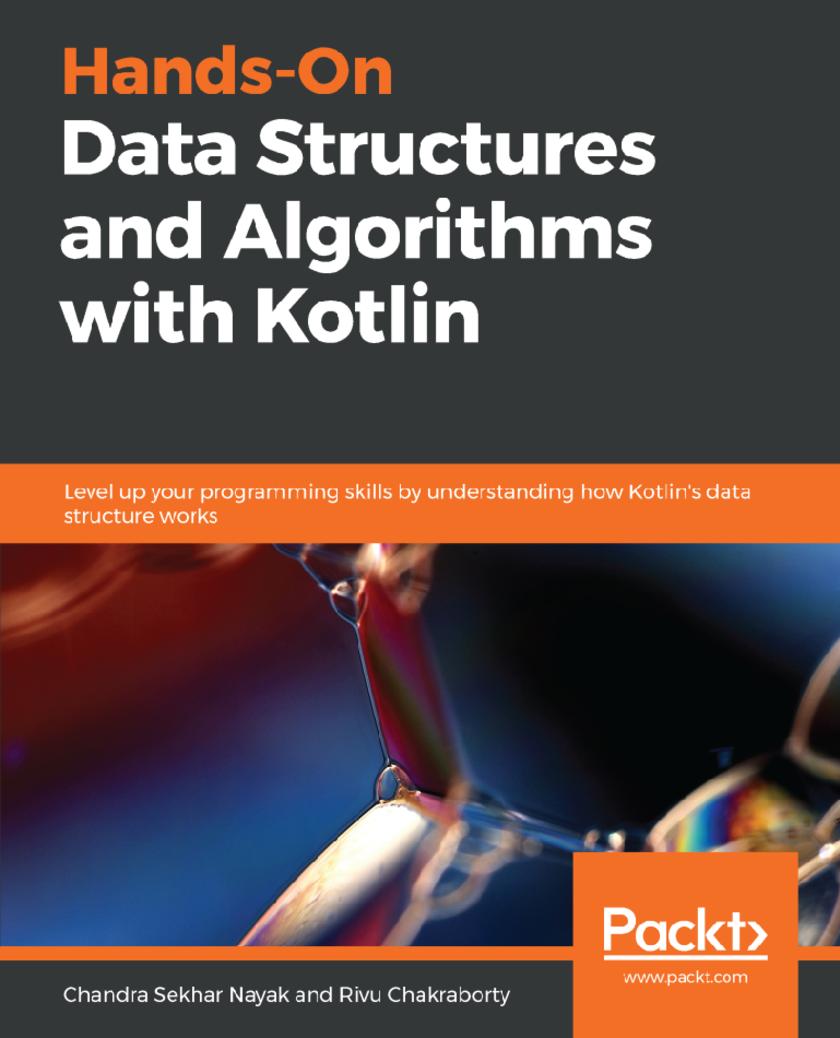
Hands-On Data Structures and Algorithms with Kotlin
¥63.21
Understand and solve complex computational problems and write efficient code with Kotlin Key Features * Learn about important data structures such as lists, arrays, queues, and stacks * Design custom algorithms for real-life implementations * Identify suitable tools for different scenarios and deliver immediate results Book Description Data structures and algorithms are more than just theoretical concepts. They help you become familiar with computational methods for solving problems and writing logical code. Equipped with this knowledge, you can write efficient programs that run faster and use less memory. Hands-On Data Structures and Algorithms with Kotlin book starts with the basics of algorithms and data structures, helping you get to grips with the fundamentals and measure complexity. You'll then move on to exploring the basics of functional programming while getting used to thinking recursively. Packed with plenty of examples along the way, this book will help you grasp each concept easily. In addition to this, you'll get a clear understanding of how the data structures in Kotlin's collection framework work internally. By the end of this book, you will be able to apply the theory of data structures and algorithms to work out real-world problems. What you will learn * Understand the basic principles of algorithms and data structures * Explore general-purpose data structures with arrays and linked lists * Get to grips with the basics of stacks, queues, and double-ended queues * Understand functional programming and related data structures * Use performant searching and efficient sorting * Uncover how Kotlin's collection framework functions * Become adept at implementing different types of maps Who this book is for If you're a Kotlin developer who wants to learn the intricacies of implementing data structures and algorithms for scalable application development, this book is for you.
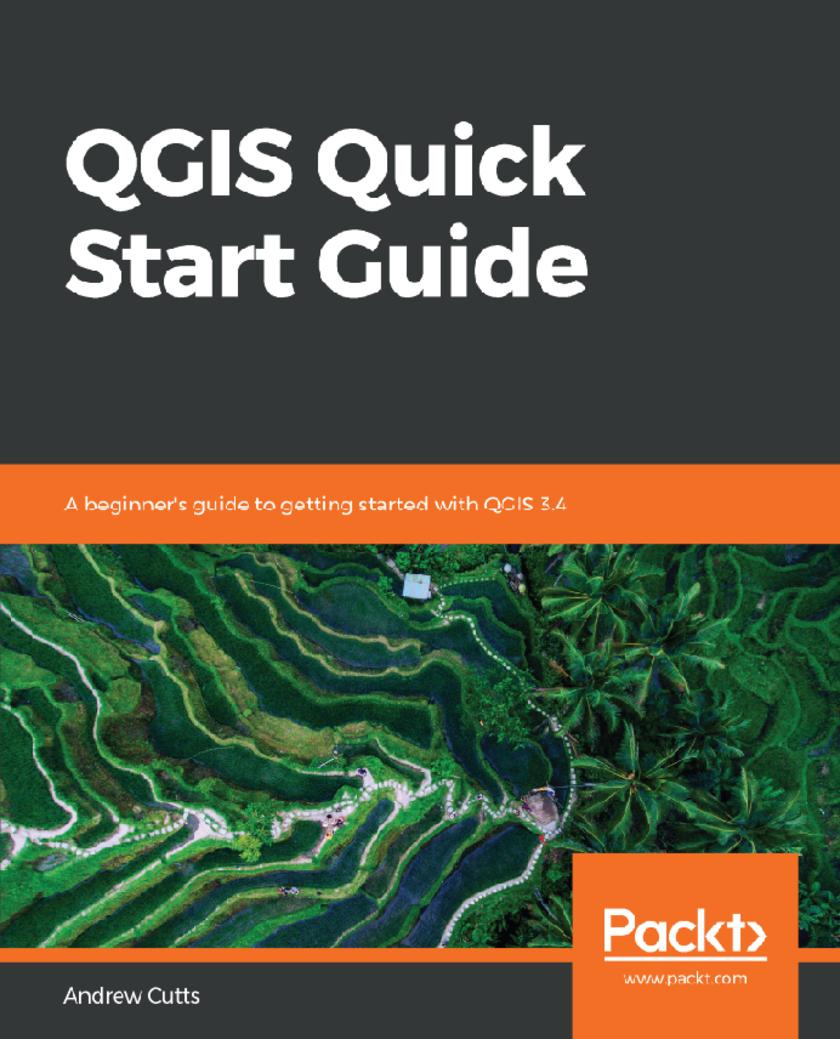
QGIS Quick Start Guide
¥54.49
Step through loading GIS data, creating GIS data, styling GIS and making maps with QGIS following a simple narrative that will allow you to build confidence as you progress. Key Features * Work with GIS data, a step by step guide from creation to making a map * Perform geoprocessing tasks and automate them using model builder * Explore a range of features in QGIS 3.4, discover the power behind open source desktop GIS Book Description QGIS is a user friendly, open source geographic information system (GIS). The popularity of open source GIS and QGIS, in particular, has been growing rapidly over the last few years. This book is designed to help beginners learn about all the tools required to use QGIS 3.4. This book will provide you with clear, step-by-step instructions to help you apply your GIS knowledge to QGIS. You begin with an overview of QGIS 3.4 and its installation. You will learn how to load existing spatial data and create vector data from scratch. You will then be creating styles and labels for maps. The final two chapters demonstrate the Processing toolbox and include a brief investigation on how to extend QGIS. Throughout this book, we will be using the GeoPackage format, and we will also discuss how QGIS can support many different types of data. Finally, you will learn where to get help and how to become engaged with the GIS community. What you will learn * Use existing data to interact with the canvas via zoom/pan/selection * Create vector data and a GeoPackage and build a simple project around it * Style data, both vector and raster data, using the Layer Styling Panel * Design, label, save, and export maps using the data you have created * Analyze spatial queries using the Processing toolbox * Expand QGIS with the help of plugins, model builder, and the command line Who this book is for If you know the basic functions and processes of GIS, and want to learn to use QGIS to analyze geospatial data and create rich mapping applications, then this is the book for you.
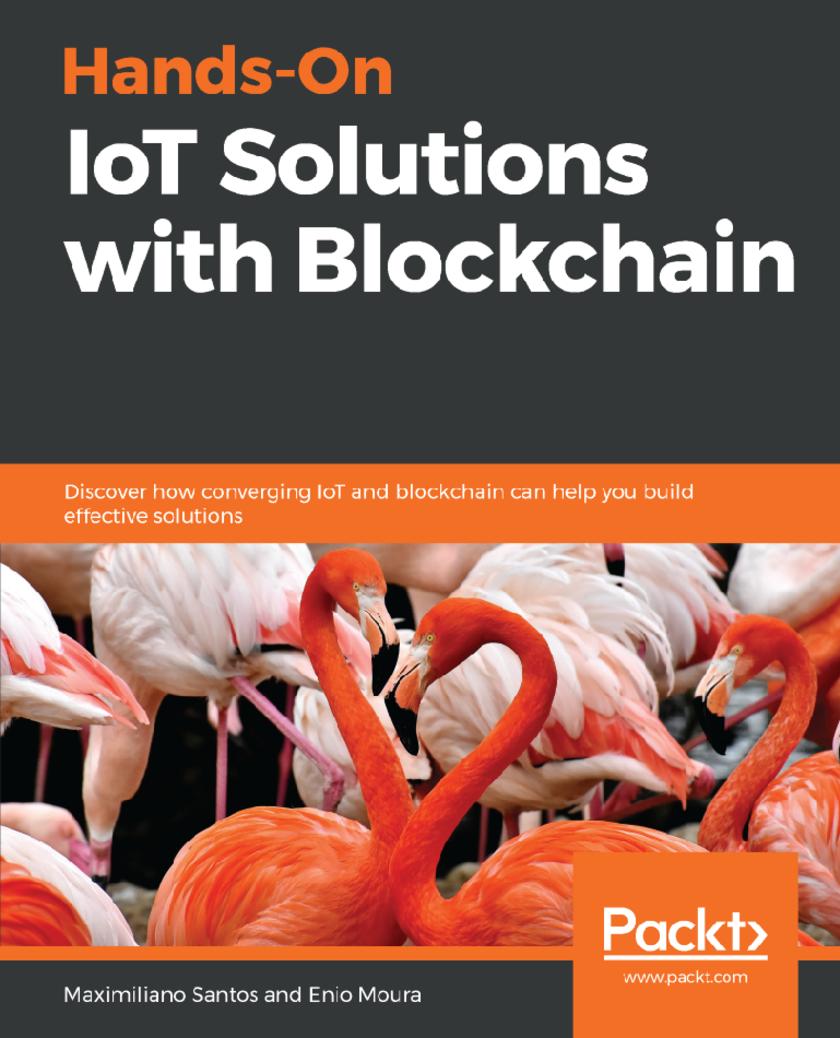
Hands-On IoT Solutions with Blockchain
¥63.21
Integrate an end-to-end logistic chain using IBM Blockchain and IoT platforms Key Features *Explore practical implementation of ledger technology in the IoT architecture *Study security best practices for your smart devices *Understand Blockchain implementation for end-to-end IoT solutions Book Description Blockchain has been the hot topic of late thanks to cryptocurrencies. To make matters more interesting, the financial market is looking for ways to reduce operational costs and generate new business models, and this is where blockchain solutions come into the picture. In addition to this, with Internet of Things (IoT) trending and Arduino, Raspberry Pi, and other devices flooding the market, you can now create cheap devices even at home. Hands-On IoT Solutions with Blockchain starts with an overview of IoT concepts in the current business scenario. It then helps you develop your own device on the IBM Watson IoT platform and create your fi rst IoT solution using Watson and Intel Edison.Once you are familiar with IoT, you will learn about Blockchain technology and its use cases. You will also work with the Hyperledger framework and develop your own Blockchain network. As you progress through the chapters, you'll work with problem statements and learn how to design your solution architecture so that you can create your own integrated Blockchain and IoT solution. The next set of chapters will explain how to implement end-to-end Blockchain solutions with IoT using the IBM Cloud platform. By the end of this book, you will have mastered the convergence of IoT and Blockchain technology and exploited the best practices and drivers to develop a bulletproof integrated solution. What you will learn *Understand the key roles of IoT in the current market *Study the different aspects of IBM Watson IoT platform *Create devices, gateways, and applications connected to the platform *Explore the fundamentals of Blockchain *Define good use cases for Blockchain *Discover the Hyperledger Fabric and Composer frameworks *Develop an IBM Watson IoT application using a Intel Edison *Integrate IoT with the Blockchain platform Who this book is for Hands-On IoT Solutions with Blockchain is for you if you are an Internet of Things (IoT) analyst, architect, engineer, or any stakeholder responsible for security mechanisms on an IoT infrastructure. This book is also for IT professionals who want to start developing solutions using Blockchain and IoT on the IBM Cloud platform. Basic understanding of IoT will assist you in understanding key concepts covered in the book.
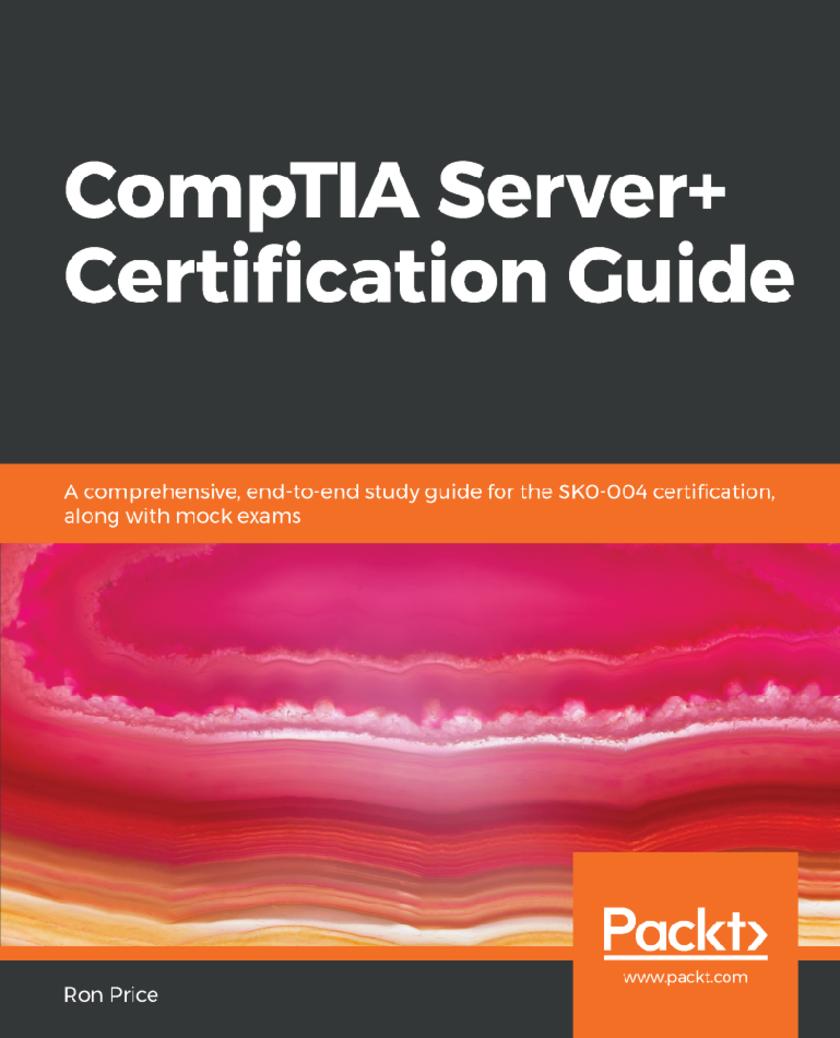
CompTIA Server+ Certification Guide
¥73.02
Master the concepts and techniques that will enable you to succeed on the SK0-004 exam the first time with the help of this study guide Key Features * Explore virtualisation, IPv4 & IPv6 networking, administration and more * Enhancing limited knowledge of server configuration and function * A study guide that covers the objectives for the certification examination Book Description CompTIA Server+ Certification is one of the top 5 IT certifications that is vendor neutral.System administrators opt for CompTIA server+ Certification to gain advanced knowledge of concepts including troubleshooting and networking. This book will initially start with the configuration of a basic network server and the configuration for each of its myriad roles. The next set of chapters will provide an overview of the responsibilities and tasks performed by a system administrator to manage and maintain a network server. Moving ahead, you will learn the basic security technologies, methods, and procedures that can be applied to a server and its network. Next, you will cover the troubleshooting procedures and methods in general, and specifically for hardware, software, networks, storage devices, and security applications. Toward the end of this book, we will cover a number of troubleshooting and security mitigation concepts for running admin servers with ease. This guide will be augmented by test questions and mock papers that will help you obtain the necessary certification. By the end of this book, you will be in a position to clear Server+ Certification with ease. What you will learn * Understand the purpose and role of a server in a computer network * Review computer hardware common to network servers * Detail the function and configuration of network operating systems * Describe the functions and tasks of network operating system administration * Explain the various data storage options on a computer network * Detail the need for, and the functioning and application of, network and server security * Describe the operational elements of a network provided by a server * Explain the processes and methods involved in troubleshooting server issues Who this book is for This book is targeted towards professionals seeking to gain the CompTIA Server+ certification. People coming from a Microsoft background with basic operating system and networking skills will also find this book useful. Basic experience working with system administration is mandatory.

ReasonML Quick Start Guide
¥54.49
A hands on approach to learning ReasonML from the perspective of a web developer. Key Features * Hands on learning by building a real world app shell that includes client-side routing and more. * Understand Reason’s ecosystem including BuckleScript and various npm workflows. * Learn how Reason differs from TypeScript and Flow, and how to use it to make refactoring less stressful. Book Description ReasonML, also known as Reason, is a new syntax and toolchain for OCaml that was created by Facebook and is meant to be approachable for web developers. Although OCaml has several resources, most of them are from the perspective of systems development. This book, alternatively, explores Reason from the perspective of web development. You'll learn how to use Reason to build safer, simpler React applications and why you would want to do so. Reason supports immutability by default, which works quite well in the context of React. In learning Reason, you will also learn about its ecosystem – BuckleScript, JavaScript interoperability, and various npm workflows. We learn by building a real-world app shell, including a client-side router with page transitions, that we can customize for any Reason project. You'll learn how to leverage OCaml's excellent type system to enforce guarantees about business logic, as well as preventing runtime type errors.You'll also see how the type system can help offload concerns that we once had to keep in our heads. We'll explore using CSS-in-Reason, how to use external JSON in Reason, and how to unit-test critical business logic. By the end of the book, you'll understand why Reason is exploding in popularity and will have a solid foundation on which to continue your journey with Reason. What you will learn * Learn why Reason is exploding in popularity and why it's the future of React * Become familiar with Reason's syntax and semantics * Learn about Reason's ecosystem: BuckleScript and JavaScript interoperability * Learn how to build React applications with Reason * Learn how to use Reason's type system as a tool to provide amazing guarantees * Gain a solid foundation on which to continue your journey Who this book is for The target audience of this book is web developers who are somewhat familiar with ReactJS and who want to learn why ReasonML is the future of ReactJS.
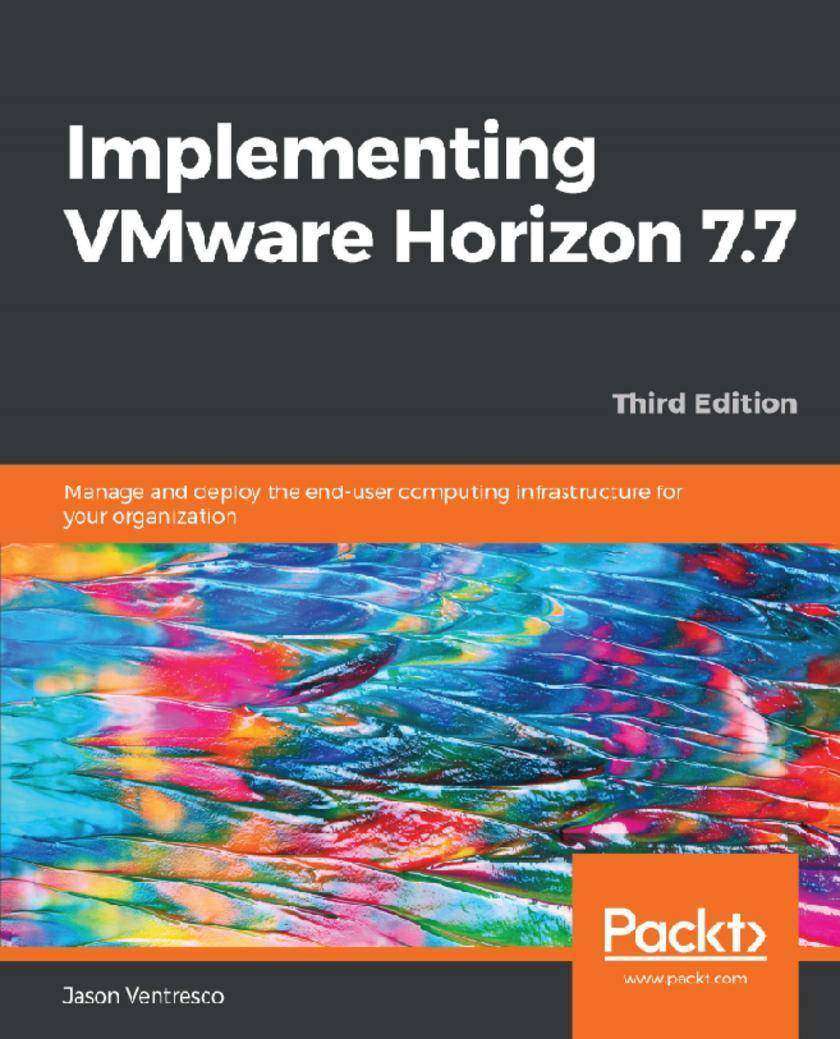
Implementing VMware Horizon 7.7
¥90.46
Effectively implement features and components for any computing environment Key Features *Explore the latest features of VMware Horizon 7.7 *Virtualize your desktop infrastructure using new features introduced in Horizon *Implement App Volumes and User Environment Manager in your infrastructure Book Description This third edition of Implementing VMware Horizon 7.7 has been updated to get you up to speed with VMware Horizon 7.7 by showing you how to use its key features and deploying an end-user computing infrastructure for your own organization. The book begins by guiding you on how to deploy all the core requirements for a VMware Horizon infrastructure. It then moves on to show you how to provision and administer end-user computing resources using VMware Horizon. You’ll not only be able to deploy the core VMware Horizon features, but you’ll also be able to implement new features, such as the Just-in-Time Management Platform (JMP) and the Horizon Console. You’ll also focus on the latest features and components of the Horizon platform and learn when and how they are used. By the end of the book, you will have developed a solid understanding of how your organization can benefit from the capabilities VMware Horizon offers and how each of its components is implemented. What you will learn *Work with the different products that make up VMware Horizon *Implement a multi-site VMware Horizon Pod using the Cloud Pod Architecture feature *Deploy and configure VMware Horizon’s optional components *Implement and maintain Microsoft RDSH, Horizon Linux, and Windows Desktop Pools and RDSH Application Pools *Configure and manage Horizon remotely using PowerCLI *Learn about the Microsoft Windows Group Policy templates for Horizon *Understand how to manage the SSL certificates for each of the VMware Horizon components Who this book is for If you’re a system administrator, solutions architect, or desktop engineer looking to level up your skills working with VMware's Horizon ecosystem and want to build a successful deployment strategy for desktops and applications, this book is for you.
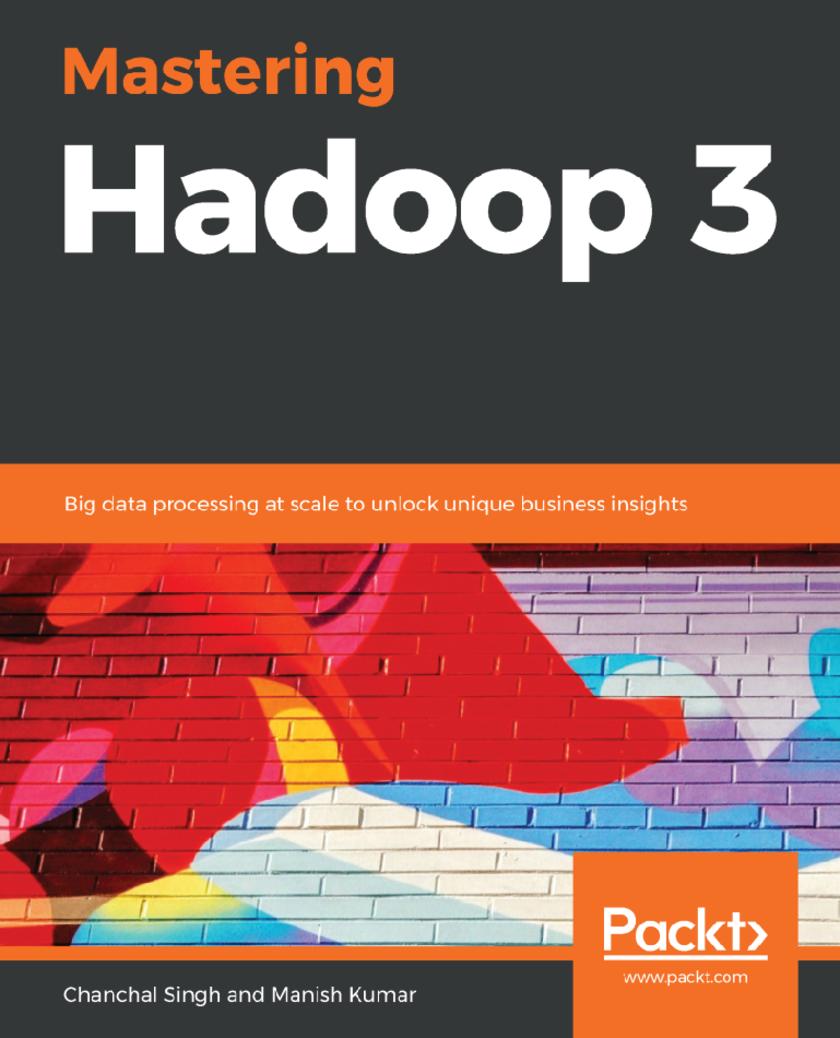
Mastering Hadoop 3
¥99.18
A comprehensive guide to mastering the most advanced Hadoop 3 concepts Key Features * Get to grips with the newly introduced features and capabilities of Hadoop 3 * Crunch and process data using MapReduce, YARN, and a host of tools within the Hadoop ecosystem * Sharpen your Hadoop skills with real-world case studies and code Book Description Apache Hadoop is one of the most popular big data solutions for distributed storage and for processing large chunks of data. With Hadoop 3, Apache promises to provide a high-performance, more fault-tolerant, and highly efficient big data processing platform, with a focus on improved scalability and increased efficiency. With this guide, you’ll understand advanced concepts of the Hadoop ecosystem tool. You’ll learn how Hadoop works internally, study advanced concepts of different ecosystem tools, discover solutions to real-world use cases, and understand how to secure your cluster. It will then walk you through HDFS, YARN, MapReduce, and Hadoop 3 concepts. You’ll be able to address common challenges like using Kafka efficiently, designing low latency, reliable message delivery Kafka systems, and handling high data volumes. As you advance, you’ll discover how to address major challenges when building an enterprise-grade messaging system, and how to use different stream processing systems along with Kafka to fulfil your enterprise goals. By the end of this book, you’ll have a complete understanding of how components in the Hadoop ecosystem are effectively integrated to implement a fast and reliable data pipeline, and you’ll be equipped to tackle a range of real-world problems in data pipelines. What you will learn * Gain an in-depth understanding of distributed computing using Hadoop 3 * Develop enterprise-grade applications using Apache Spark, Flink, and more * Build scalable and high-performance Hadoop data pipelines with security, monitoring, and data governance * Explore batch data processing patterns and how to model data in Hadoop * Master best practices for enterprises using, or planning to use, Hadoop 3 as a data platform * Understand security aspects of Hadoop, including authorization and authentication Who this book is for If you want to become a big data professional by mastering the advanced concepts of Hadoop, this book is for you. You’ll also find this book useful if you’re a Hadoop professional looking to strengthen your knowledge of the Hadoop ecosystem. Fundamental knowledge of the Java programming language and basics of Hadoop is necessary to get started with this book.
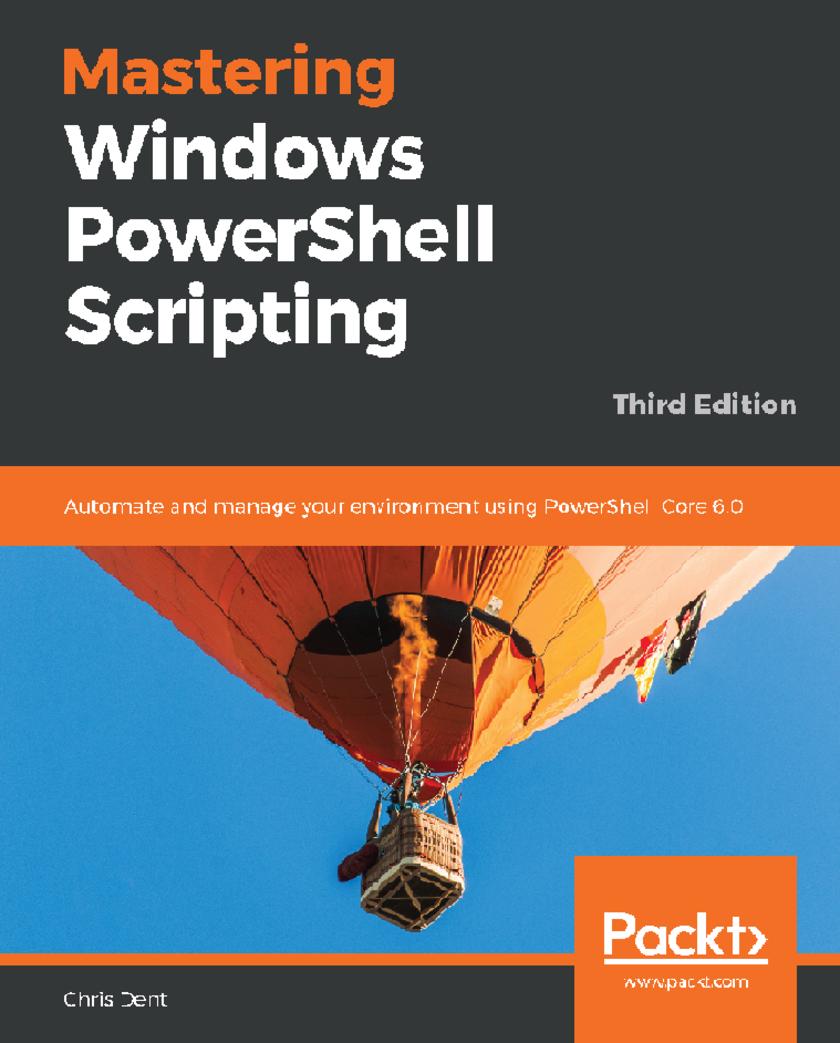
Mastering Windows PowerShell Scripting
¥81.74
Grasp advanced PowerShell Core 6.0 functionalities to automate your environment Key Features * Keep up with changes introduced in PowerShell Core 6.0 * Easily maintain appropriate compatibility with older versions * Automate complex tasks, manipulate data, and secure your environment with PowerShell Core 6.0 Book Description PowerShell scripts offer a handy way to automate various chores, however working effectively with these scripts can be a difficult task. This comprehensive guide starts with the fundamentals before moving on to advanced-level topics to help you become a PowerShell Core 6.0 expert. The first module, PowerShell Core 6.0 Fundamentals, begins with the new features of PowerShell Core 6.0, installing it on Linux, and working with parameters, objects and .NET classes from within PowerShell Core 6.0. As you make your way through the chapters, you'll see how to efficiently manage large amounts of data and interact with other services using PowerShell Core 6.0. You'll be able to make the most of PowerShell Core 6.0's powerful automation feature, where you will have different methods available to parse data and manipulate regular expressions and Windows Management Instrumentation (WMI). After having explored automation, you will enter the extending PowerShell Core 6.0 module, covering asynchronous processing and desired state configuration. In the last module, you will learn to extend PowerShell Core 6.0 using advanced scripts and filters, and also debug issues along with working on error handling techniques. By the end of this book, you will be an expert in scripting with PowerShell Core 6.0. What you will learn * Optimize code through the use of functions, switches, and looping structures * Work with objects and operators to test and manipulate data * Parse and manipulate different data types * Create scripts and functions using PowerShell * Use jobs, events, and popular public modules which assist with implementing multithreading * Write .NET classes with ease within the PowerShell * Create and implement regular expressions in PowerShell scripts * Make use of advanced techniques to define and restrict the behavior of parameters Who this book is for If you are a system administrator who wants to become an expert in controlling and automating your Windows environment, then Mastering Windows PowerShell Scripting is for you. It is also ideal for those new to the PowerShell language.
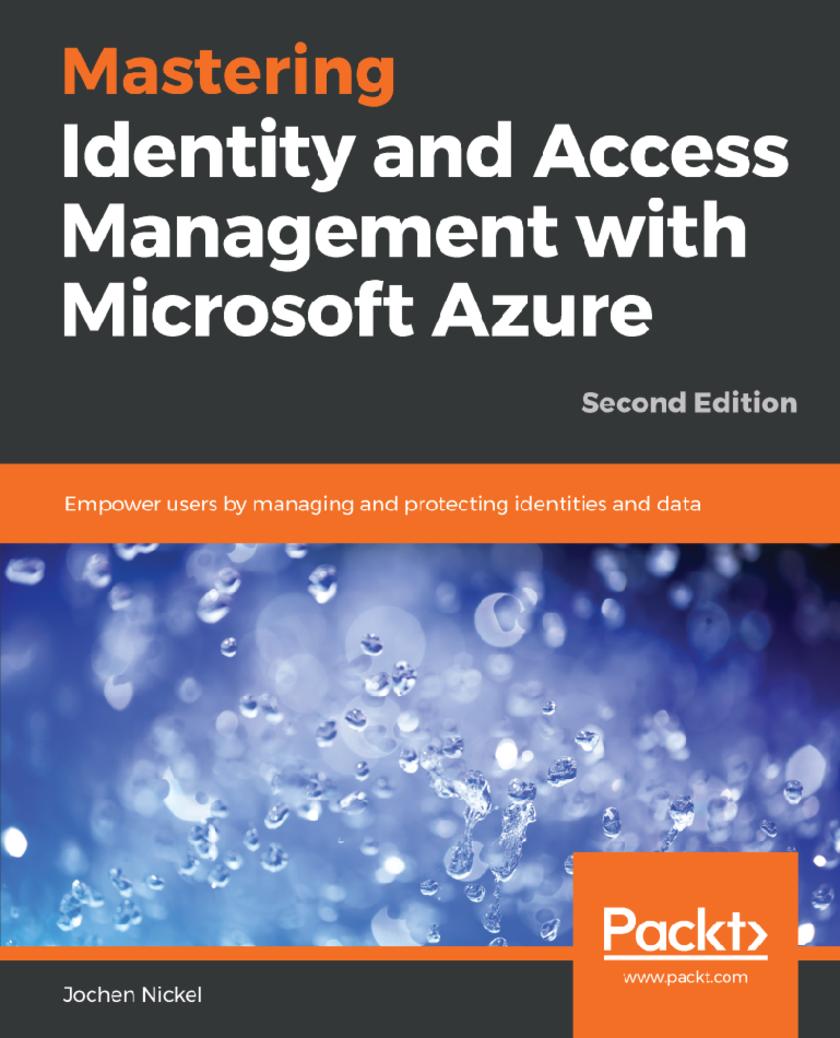
Mastering Identity and Access Management with Microsoft Azure
¥108.99
Start empowering users and protecting corporate data, while managing identities and access with Microsoft Azure in different environments Key Features * Understand how to identify and manage business drivers during transitions * Explore Microsoft Identity and Access Management as a Service (IDaaS) solution * Over 40 playbooks to support your learning process with practical guidelines Book Description Microsoft Azure and its Identity and access management are at the heart of Microsoft's software as service products, including Office 365, Dynamics CRM, and Enterprise Mobility Management. It is crucial to master Microsoft Azure in order to be able to work with the Microsoft Cloud effectively. You’ll begin by identifying the benefits of Microsoft Azure in the field of identity and access management. Working through the functionality of identity and access management as a service, you will get a full overview of the Microsoft strategy. Understanding identity synchronization will help you to provide a well-managed identity. Project scenarios and examples will enable you to understand, troubleshoot, and develop on essential authentication protocols and publishing scenarios. Finally, you will acquire a thorough understanding of Microsoft Information protection technologies. What you will learn * Apply technical descriptions to your business needs and deployments * Manage cloud-only, simple, and complex hybrid environments * Apply correct and efficient monitoring and identity protection strategies * Design and deploy custom Identity and access management solutions * Build a complete identity and access management life cycle * Understand authentication and application publishing mechanisms * Use and understand the most crucial identity synchronization scenarios * Implement a suitable information protection strategy Who this book is for This book is a perfect companion for developers, cyber security specialists, system and security engineers, IT consultants/architects, and system administrators who are looking for perfectly up–to-date hybrid and cloud-only scenarios. You should have some understanding of security solutions, Active Directory, access privileges/rights, and authentication methods. Programming knowledge is not required but can be helpful for using PowerShell or working with APIs to customize your solutions.
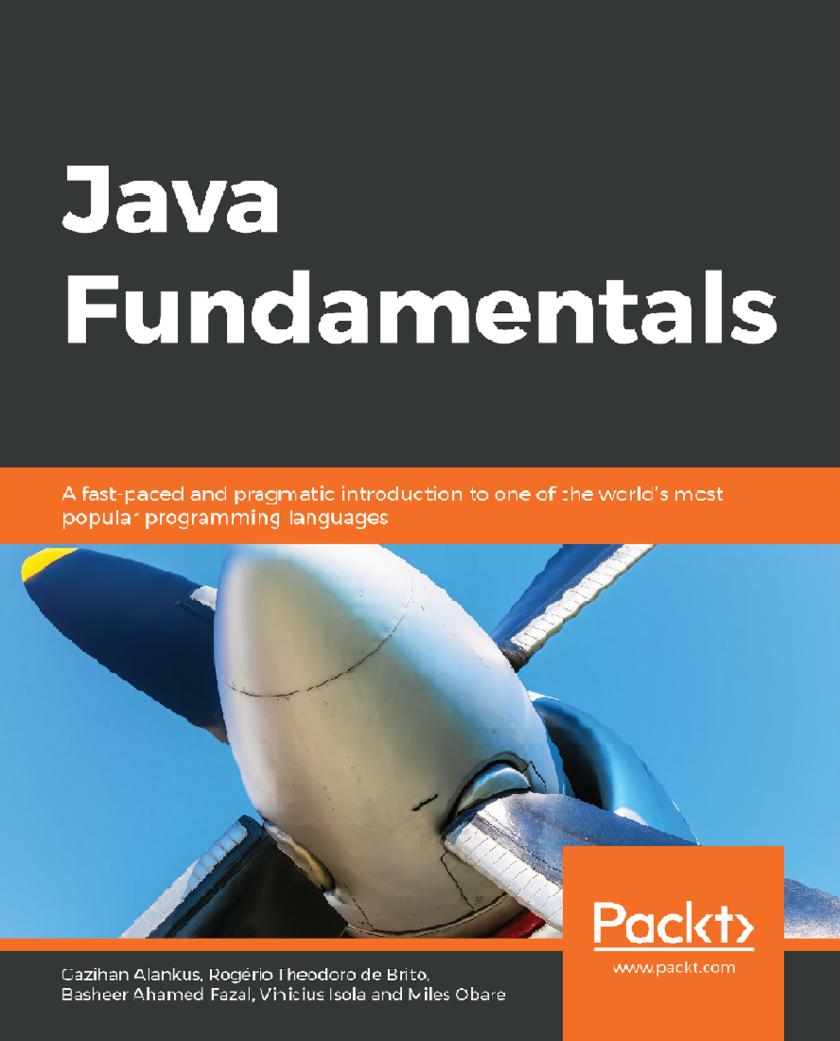
Java Fundamentals
¥54.49
Enhance your career options with this well-crafted object-oriented programming language that enjoys the support of an enormous ecosystem of tools and libraries Key Features * Get introduced to Java, its features, and its ecosystem * Understand how Java uses object-oriented programming * Become an expert Java exception handler Book Description Since its inception, Java has stormed the programming world. Its features and functionalities provide developers with the tools needed to write robust cross-platform applications. Java Fundamentals introduces you to these tools and functionalities that will enable you to create Java programs. The book begins with an introduction to the language, its philosophy, and evolution over time, until the latest release. You'll learn how the javac/java tools work and what Java packages are - the way a Java program is usually organized. Once you are comfortable with this, you'll be introduced to advanced concepts of the language, such as control flow keywords. You'll explore object-oriented programming and the part it plays in making Java what it is. In the concluding chapters, you'll get to grips with classes, typecasting, and interfaces, and understand the use of data structures, arrays, strings, handling exceptions, and creating generics. By the end of this book, you will have learned to write programs, automate tasks, and follow advanced courses on algorithms and data structures or explore more advanced Java courses. What you will learn * Create and run Java programs * Use data types, data structures, and control flow in your code * Implement best practices while creating objects * Work with constructors and inheritance * Understand advanced data structures to organize and store data * Employ generics for stronger check-types during compilation * Learn to handle exceptions in your code Who this book is for Java Fundamentals is designed for tech enthusiasts who are familiar with some programming languages and want a quick introduction to the most important principles of Java.

Hands-On Full-Stack Web Development with GraphQL and React
¥81.74
Unearth the power of GraphQL, React, Apollo, Node, and Express to build a scalable, production ready application Key Features * Build full stack applications with modern APIs using GraphQL and Apollo * Integrate Apollo into React and build frontend components using GraphQL * Implement a self-updating notification pop-up with a unique GraphQL feature called Subscriptions Book Description React, one of the most widely used JavaScript frameworks, allows developers to build fast and scalable front end applications for any use case. GraphQL is the modern way of querying an API. It represents an alternative to REST and is the next evolution in web development. Combining these two revolutionary technologies will give you a future-proof and scalable stack you can start building your business around. This book will guide you in implementing applications by using React, Apollo, Node.js and SQL. We'll focus on solving complex problems with GraphQL, such as abstracting multi-table database architectures and handling image uploads. Our client, and server will be powered by Apollo. Finally we will go ahead and build a complete Graphbook. While building the app, we'll cover the tricky parts of connecting React to the back end, and maintaining and synchronizing state. We'll learn all about querying data and authenticating users. We'll write test cases to verify the front end and back end functionality for our application and cover deployment. By the end of the book, you will be proficient in using GraphQL and React for your full-stack development requirements. What you will learn * Resolve data from multi-table database and system architectures * Build a GraphQL API by implementing models and schemas with Apollo and Sequelize * Set up an Apollo Client and build front end components using React * Use Mocha to test your full-stack application * Write complex React components and share data across them * Deploy your application using Docker Who this book is for The book is for web developers who want to enhance their skills and build complete full stack applications using industry standards. Familiarity with JavaScript, React, and GraphQL is expected to get the most from this book.
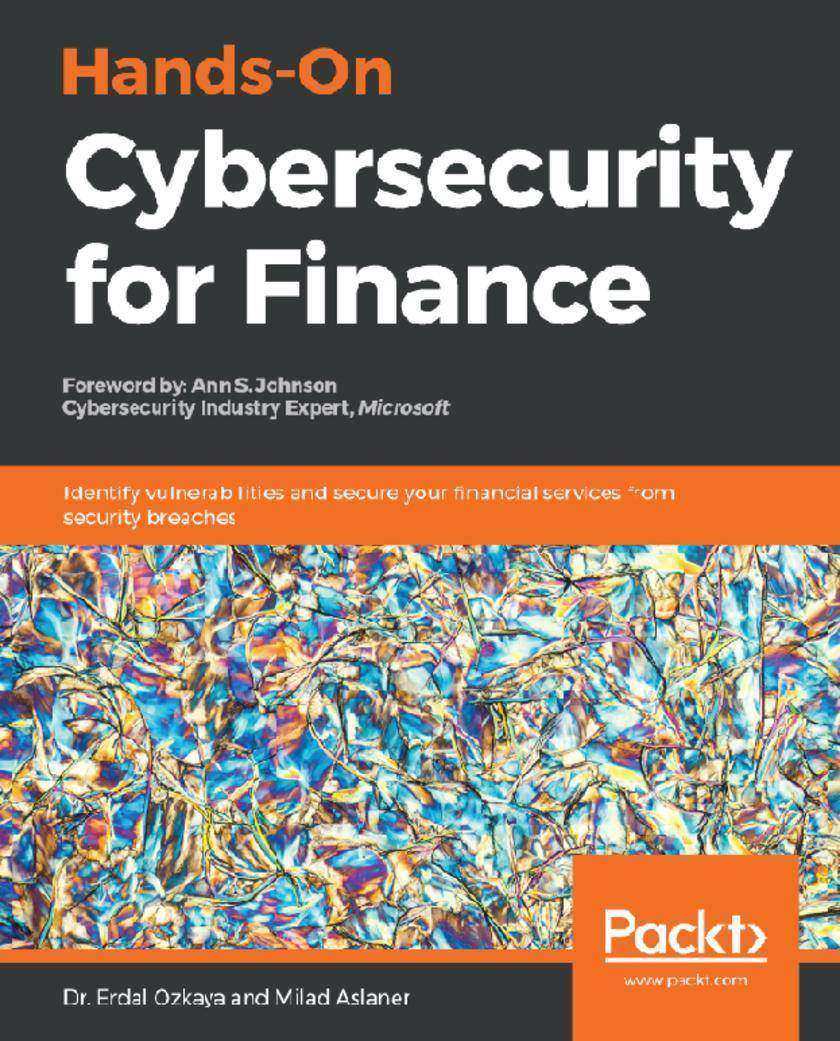
Hands-On Cybersecurity for Finance
¥81.74
A comprehensive guide that will give you hands-on experience to study and overcome financial cyber threats Key Features * Protect your financial environment with cybersecurity practices and methodologies * Identify vulnerabilities such as data manipulation and fraudulent transactions * Provide end-to-end protection within organizations Book Description Organizations have always been a target of cybercrime. Hands-On Cybersecurity for Finance teaches you how to successfully defend your system against common cyber threats, making sure your financial services are a step ahead in terms of security. The book begins by providing an overall description of cybersecurity, guiding you through some of the most important services and technologies currently at risk from cyber threats. Once you have familiarized yourself with the topic, you will explore specific technologies and threats based on case studies and real-life scenarios. As you progress through the chapters, you will discover vulnerabilities and bugs (including the human risk factor), gaining an expert-level view of the most recent threats. You'll then explore information on how you can achieve data and infrastructure protection. In the concluding chapters, you will cover recent and significant updates to procedures and configurations, accompanied by important details related to cybersecurity research and development in IT-based financial services. By the end of the book, you will have gained a basic understanding of the future of information security and will be able to protect financial services and their related infrastructures. What you will learn * Understand the cyber threats faced by organizations * Discover how to identify attackers * Perform vulnerability assessment, software testing, and pentesting * Defend your financial cyberspace using mitigation techniques and remediation plans * Implement encryption and decryption * Understand how Artificial Intelligence (AI) affects cybersecurity Who this book is for Hands-On Cybersecurity for Finance is for you if you are a security architect, cyber risk manager, or pentester looking to secure your organization. Basic understanding of cybersecurity tools and practices will help you get the most out of this book.
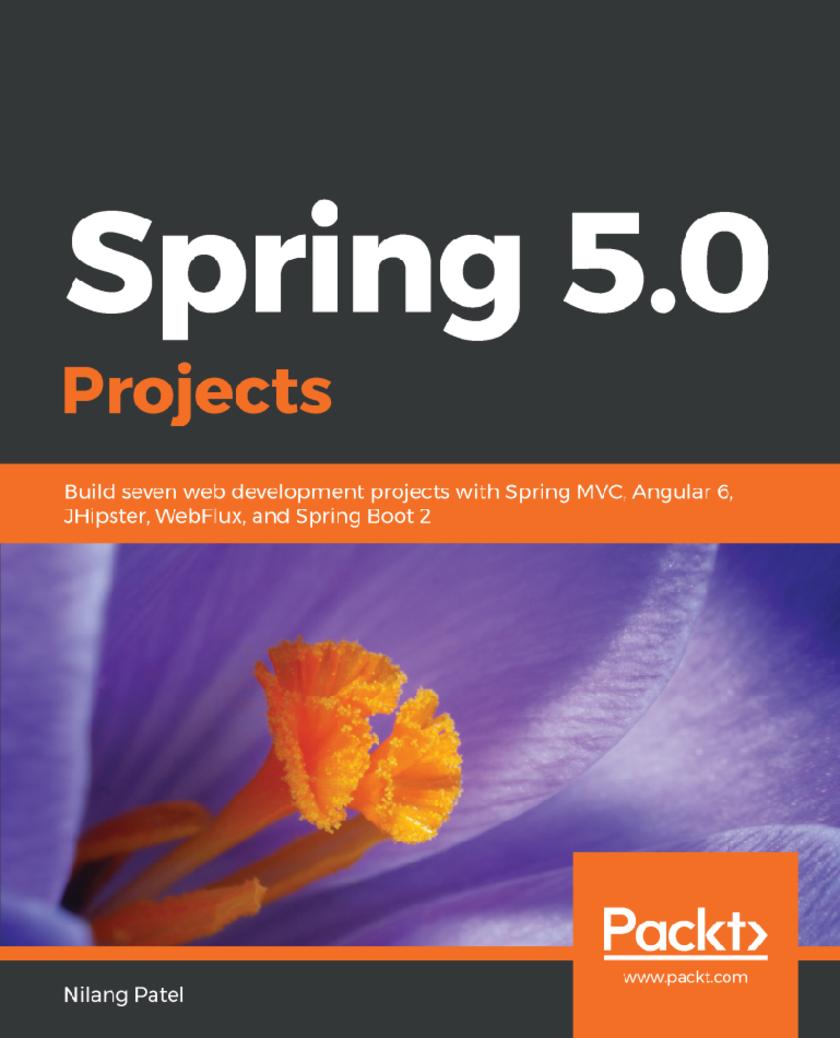
Spring 5.0 Projects
¥81.74
Discover the latest features of Spring framework by building robust, fast, and reactive web applications Key Features * Take advantage of all the features of Spring 5.0 with third party tools to build a robust back end * Secure Spring based web application using Spring Security framework with LDAP and OAuth protocol * Develop robust and scalable microservice based applications on Spring Cloud, using Spring Boot Book Description Spring makes it easy to create RESTful applications, merge with social services, communicate with modern databases, secure your system, and make your code modular and easy to test. With the arrival of Spring Boot, developers can really focus on the code and deliver great value, with minimal contour. This book will show you how to build various projects in Spring 5.0, using its features and third party tools. We'll start by creating a web application using Spring MVC, Spring Data, the World Bank API for some statistics on different countries, and MySQL database. Moving ahead, you'll build a RESTful web services application using Spring WebFlux framework. You'll be then taken through creating a Spring Boot-based simple blog management system, which uses Elasticsearch as the data store. Then, you'll use Spring Security with the LDAP libraries for authenticating users and create a central authentication and authorization server using OAuth 2 protocol. Further, you'll understand how to create Spring Boot-based monolithic application using JHipster. Toward the end, we'll create an online book store with microservice architecture using Spring Cloud and Net?ix OSS components, and a task management system using Spring and Kotlin. By the end of the book, you'll be able to create coherent and ?exible real-time web applications using Spring Framework. What you will learn * Build Spring based application using Bootstrap template and JQuery * Understand the Spring WebFlux framework and how it uses Reactor library * Interact with Elasticsearch for indexing, querying, and aggregating data * Create a simple monolithic application using JHipster * Use Spring Security and Spring Security LDAP and OAuth libraries for Authentication * Develop a microservice-based application with Spring Cloud and Netflix * Work on Spring Framework with Kotlin Who this book is for This book is for competent Spring developers who wish to understand how to develop complex yet flexible applications with Spring. You must have a good knowledge of Java programming and be familiar with the basics of Spring.




 购物车
购物车 个人中心
个人中心



